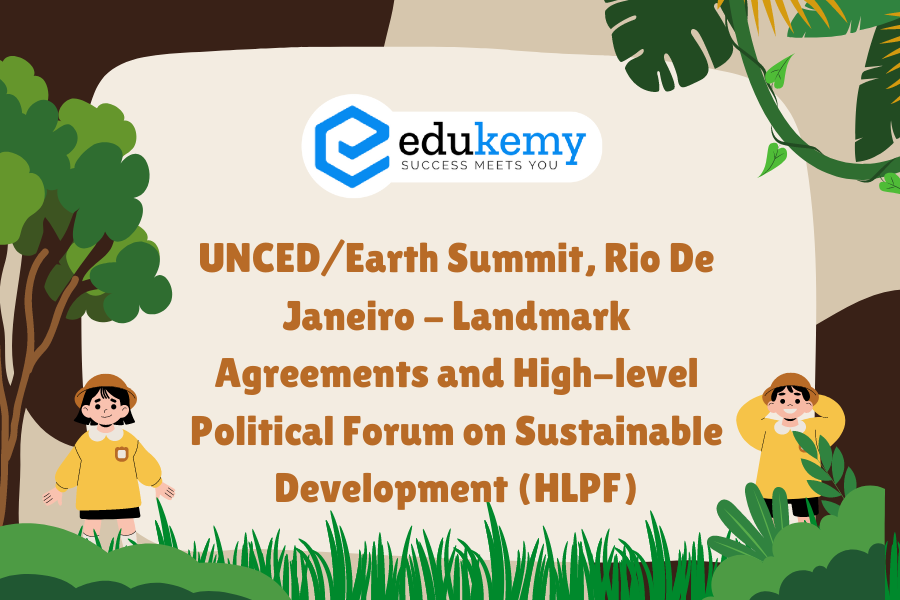- The UNCED, also recognized as the ‘Earth Summit,’ took place in Rio de Janeiro, Brazil, spanning from June 3 to 14, 1992.
- This global conference was convened to commemorate the 20th anniversary of the inaugural Human Environment Conference held in Stockholm, Sweden, in 1972.
- The conference underscored the intricate interdependence of various social, economic, and environmental factors, emphasizing their interconnected evolution.
- It emphasized that achievements in one sector necessitate coordinated actions in others to ensure sustained progress over time.
- The primary aim of the Rio ‘Earth Summit’ was to formulate a comprehensive agenda and a fresh framework for international initiatives addressing environmental and developmental concerns.
- The objective was to provide guidance for international cooperation and development policies in the twenty-first century.
- The summit’s consensus highlighted that sustainable development was an achievable objective for people worldwide, irrespective of their locations—whether at the local, national, regional, or international levels.
The outcomes of the Conference yielded several significant documents:
- The Framework Convention on Climate Change (UNFCCC)
- The Convention on Biological Diversity
- The Statement on Forest Principles
- The Rio Declaration
- Agenda 21
Contents
UN WORLD SUMMIT
- The UN World Summit in 2005, held at the United Nations Headquarters in New York, convened over 170 heads of state and government.
- During the Summit, leaders from around the world reached agreements to address major global challenges.
- These agreements included strong commitments to achieve the development goals outlined in the Millennium Declaration by 2015.
- Governments committed to providing an additional $50 billion annually to combat poverty and sought innovative sources of development finance.
- Additionally, leaders expressed dedication to ensuring long-term debt sustainability.
- The summit participants firmly committed to trade liberalization and vowed to diligently implement the developmental aspects of the Doha work program.
UNFCCC- UNITED NATION FRAMEWORK CONVENTION ON CLIMATE CHANGE
- The United Nations Framework Convention on Climate Change (UNFCCC) was signed in 1992 during the United Nations Conference on Environment and Development, commonly known as the Earth Summit, Rio Summit, or Rio Conference.
- India is among the few countries that have hosted the Conference of the Parties (COP) for all three Rio conventions, including climate change (UNFCCC), biodiversity (CBD), and land (United Nations Convention to Combat Desertification).
- The UNFCCC came into force in 1994 and has been ratified by 197 countries. It serves as the foundational treaty for both the 2015 Paris Agreement and the 1997 Kyoto Protocol.
- The UNFCCC secretariat, also known as UN Climate Change, is the United Nations body responsible for supporting the global response to the threat of climate change, with its headquarters in Bonn, Germany.
- The primary objective of the UNFCCC is to achieve the stabilization of greenhouse gas concentrations in the atmosphere at a level that prevents dangerous repercussions.
- This stabilization should occur within a timeframe allowing ecosystems to adapt naturally and facilitating sustainable development.
HIGH LEVEL POLITICAL FORUM ON SUSTAINABLE DEVELOPMENT
- The United Nations High-level Political Forum on Sustainable Development (HLPF) was directed to be established in 2012 through the outcome document of the United Nations Conference on Sustainable Development (Rio+20), known as “The Future We Want.”
- Convened under the auspices of the Economic and Social Council (ECOSOC) of the United Nations, the HLPF holds its annual sessions, lasting eight days each, in July.
- This forum took the place of the Commission on Sustainable Development, which had been convening annually since 1993.
FUNCTIONS
- The HLPF serves as the principal United Nations platform for addressing sustainable development.
- It plays a pivotal role in overseeing and evaluating the progress of the 2030 Agenda for Sustainable Development on a global scale.
FAQs – EARTH SUMMIT
1. What is the Earth Summit, and when did it take place?
A: The Earth Summit, officially known as the UNCED, occurred in Rio de Janeiro, Brazil, from June 3 to 14, 1992. It commemorated the 20th anniversary of the first Human Environment Conference in Stockholm, Sweden, held in 1972.
2. What was the key focus of the Earth Summit?
A: The Earth Summit aimed to highlight the interdependence of social, economic, and environmental factors. It emphasized that progress in one sector requires coordinated actions in others for sustained development.
3. Why was the Earth Summit convened?
A: The primary objective was to formulate a comprehensive agenda and framework for international initiatives addressing environmental and developmental concerns. It aimed to guide international cooperation and development policies in the twenty-first century.
4. What was the consensus regarding sustainable development?
A: The summit concluded that sustainable development was an achievable objective for people worldwide, irrespective of their locations—whether at the local, national, regional, or international levels.
5. What significant documents resulted from the Earth Summit?
A: The outcomes included several key documents, namely the Framework Convention on Climate Change (UNFCCC), the Convention on Biological Diversity, the Statement on Forest Principles, the Rio Declaration, and Agenda 21.
In case you still have your doubts, contact us on 9811333901.
For UPSC Prelims Resources, Click here
For Daily Updates and Study Material:
Join our Telegram Channel – Edukemy for IAS
- 1. Learn through Videos – here
- 2. Be Exam Ready by Practicing Daily MCQs – here
- 3. Daily Newsletter – Get all your Current Affairs Covered – here
- 4. Mains Answer Writing Practice – here

